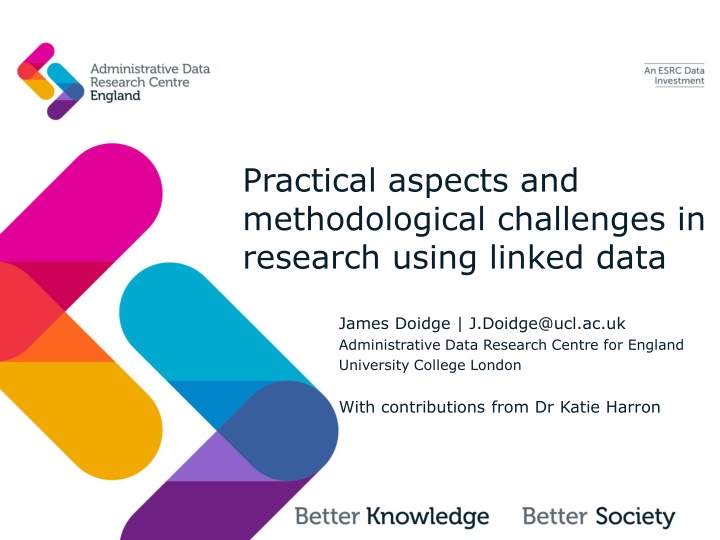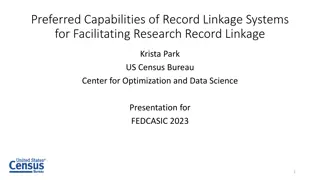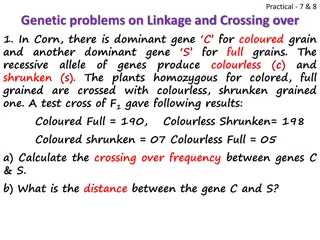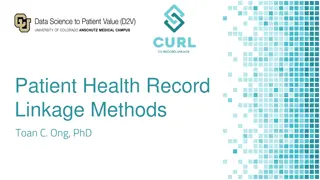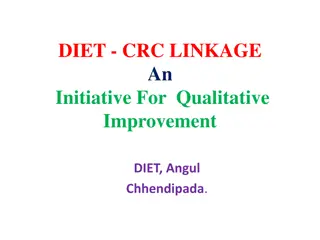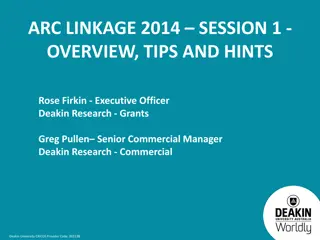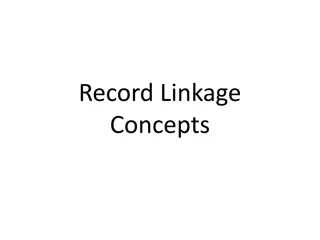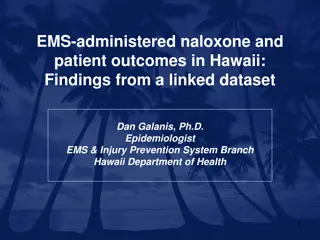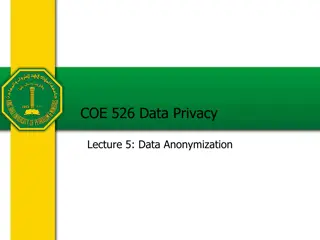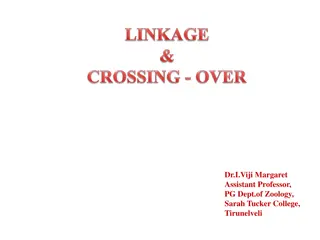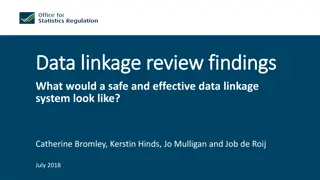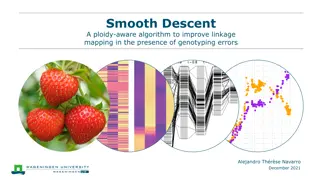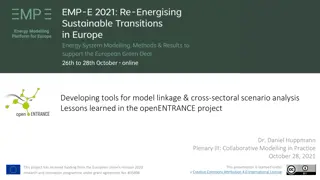Practical Aspects of Data Linkage Research
Research using linked data involves merging information from multiple sources to consolidate facts not available in individual records. Data linkage methods, such as deterministic and probabilistic linkage, are used to access and analyze linked data for various purposes, including answering research questions in healthcare, transportation, and other domains. Challenges and considerations in data linkage research are outlined to understand the complexities involved in utilizing linked data effectively.
Download Presentation

Please find below an Image/Link to download the presentation.
The content on the website is provided AS IS for your information and personal use only. It may not be sold, licensed, or shared on other websites without obtaining consent from the author.If you encounter any issues during the download, it is possible that the publisher has removed the file from their server.
You are allowed to download the files provided on this website for personal or commercial use, subject to the condition that they are used lawfully. All files are the property of their respective owners.
The content on the website is provided AS IS for your information and personal use only. It may not be sold, licensed, or shared on other websites without obtaining consent from the author.
E N D
Presentation Transcript
Practical aspects and methodological challenges in research using linked data James Doidge | J.Doidge@ucl.ac.uk Administrative Data Research Centre for England University College London With contributions from Dr Katie Harron
Part 1 PRACTICAL ASPECTS 1. What is data linkage? 2. What can linked data be used for? 3. How are records linked? 4. How to access linked data? 2
What is data linkage? A statistical definition a merging that brings together information from two or more sources of data with the object of consolidating facts concerning an individual or an event that are not available in any separate record Organisation for Economic Co-operation and Development (OECD) Glossary of Statistical Terms
What is linkage used for? To merge information from one or more datasets: when info is not recorded in the same place To evaluate data quality by triangulating corresponding information from different sources To address new research questions, avoiding the need to set up expensive cohort studies For service provision & core business activities
Answering research questions Electronic data on flight arrivals and departures Hospitalisations data
Answering research questions Drug treatment registrations (Scottish Drug Misuse Database) Conclusions: In people receiving treatment for drug dependence, discharge from a period of hospitalization marks the start of a period of heightened vulnerability to drug-related death. Deaths (ISD) hospital episodes (GROS), hepatitis C diagnoses (Health Protection Scotland)
How are data linked? Deterministic linkage Based on rules, e.g. IF records agree on NHS number and date of birth THEN consider them a match ( link them) May include many rules, often sequential from highest quality to lowest quality Probabilistic linkage For each pattern of agreement, estimate the likelihood that the record pair is a match. Then, either: 1. If expecting only one match (one:one linkage), select the record with the highest likelihood (above some minimum threshold if there may not be a match) 2. If allowing for multiple matches (one:many linkage), set a threshold beyond which all pairs are linked. Sometimes, two thresholds are chosen and records between these subjected to clerical review. 3. Or, employ imputation-based analyses 7
Deterministic vs. Probabilistic Record Linkage Deterministic linkage is generally simpler Easier to implement and interpret Less computation-intensive (faster, cheaper) but probabilistic linkage is more flexible Easier to accommodate large numbers of matching variables Easier to accommodate distance measures of partial agreement, e.g. John vs Jon ~ 75% agreement Easier to accommodate frequency-based weighting, e.g. Smith vs Doidge (agreement on a rare value is more likely to mean that records are a match) PRL is therefore generally more sensitive than deterministic linkage (produces fewer missed matches) 8
How to access linked data Who own the data? Different data providers have different legal and administrative requirements for data sharing. Have the data already been linked? If not, Who will link it? (generally requires access to identifiable data names, addresses, etc.) How will it be linked? Good quality linkage can require significant expertise and computing resources. Where will the data be stored during analysis? Researcher s own institution Data provider safe haven (VPN or local access) Third party safe haven, e.g. ADRN, ONS 9
Routine vs ad hoc data linkage Ad hoc linkage Project-by-project Linkage usually conducted by a data provider or trusted third party Routine ongoing linkage systems Can leverage information from multiple linkages Economies of scale Streamlined applications e.g. SAIL (Wales) Scottish Record Linkage System (now SILC) International examples In England, only small examples, mostly within health, e.g. ORLS CPRD HES-ONS mortality 10
Trusted third party model Data custodian 1 Data custodian 2 Identifiers 1 Identifiers 2 Linkage unit (trusted third party) Local ID 1 Local ID 2 Identifiers 1 Identifiers 2 Clinical data 2 Clinical data 1 Local ID 1 Local ID 2 Study ID Study ID Study ID Research group Study ID Study ID Clinical data 1 Clinical data 2
Approvals At least: Data providers Caldicott guardian/committee/data release office IGARD (NHS Digital) Data processing team +/- data rel Data linkers (if separate from providers) +/- : Ethics committees (may be different requirements for different data sources) Confidentiality Advisory Group (CAG; health data without consent soon to be education data too) Data protection officers Etc. 12
Timescales Anywhere from 3 months (simple project using already-linked data) to 6 years (multiple stakeholders, new linkages, bureaucratic hiccups) Common causes of delay include changes to administrative processes administrative personnel data security requirements legislation agreements between data providers scope of data request expiration of existing approvals and certifications before others are in place/data can be provided! 13
Costs Anywhere from nil to 200,000per annum Generally increase with size of data requested and complexity of processing (including linkage) required Generally higher for ad hoc linkage 14
Part 2 METHODOLOGICAL CHALLENGES 1. Administrative data Data quality Population coverage 2. Linkage error Understand it Assess it Address it 15
What is administrative data? Routinely-collected data, electronic records Information collected for specific purposes, e.g. financial management (hospital admissions) clinical management or audit registration (births and deaths) service evaluation and delivery government departments Primary purpose is not research (or linkage)
Questions to consider when using secondary/administrative data Why were the data collected? Which data had to be collected for this purpose? Which data were collected but not required? (may be poorer quality) Which relevant data were not collected? What unit were the data recorded in? People? Events? Claims? If not your intended unit of analysis, how was the dataset internally linked ? How are the data recorded? Text fields vs drop down boxes? Any validation or quality assurance? Has recording changed over time? 17
Questions (contd) Are there differences in recording practices or quality across contributors to a dataset? Between hospitals/general practices/service providers, etc. What triggers data to be recorded? Is recording related to your variables of interest? e.g. measurement of weight in people with weight problems or diabetes What is the coverage of the dataset in terms of the target population for your analysis? Has the coverage changed over time? 18
Population coverage Most administrative data requires: Access to service, which can be limited by Geography Language Disability Lifestyle/work Utilisation of the service, which can be affected by Competing services Local variation in (perceived) quality of the service Cultural factors This Photo by Unknown Author is licensed under CC BY-SA 19
Population dynamics Entry and exit from the coverage of an administrative data source is often not recorded Birth & death Immigration & emigration (interregional or international) Denominators (e.g. persons or person-time at risk) are therefore often unknown or approximate Special study designs may be required e.g. dynamic cohort designs Some exposures and outcomes may not be observed Misclassification Measurement error This Photo by Unknown Author is licensed under CC BY 20
Implications for analysis Most of these phenomena result in either Information bias Misclassification and measurement error Selection bias Bias arising from differences in the probability of inclusion in a dataset Epidemiological techniques available for addressing these Sensitivity analysis Quantitative bias analysis Lash TL, Fox MP, MacLehose RF, et al. Good practices for quantitative bias analysis. Int J Epidemiol 2014 doi: 10.1093/ije/dyu149 Lash TL, Fox MP, Fink AK. Applying Quantitative Bias Analysis to Epidemiologic Data. New York: Springer 2009. 21
Linkage error Missed links between records that belong to the same entity. Primarily caused by: Errors and missing data in matching variables Variation in the values of matching variables over time, e.g. changes of name or address False links between records that belong to different entities. Primarily caused by: Lack of discriminatory power ( uniqueness ) of matching variables 22 This Photo by Unknown Author is licensed under CC BY-SA
Classification of links Match status Match Non-match (pair from same subject) (pair from different subjects) A B Link Identified match False match Link status C D Non-link Missed match Identified non-match Sensitivity = A / (A+C) Specificity = D / (B+D) 23
QUESTION: Linkage error can cause a) Misclassification b) Measurement error c) Missing data d) Selection bias e) Loss of power ANSWER: all of the above BONUS: Anything else? Splitting & merging 24 This Photo by Unknown Author is licensed under CC BY-SA
Useful questions to ask 1. Is the presence of absence of a link meaningfully interpreted? If yes, then what would be the implications of linkage error? If no, how will you handle missed links (missing data)? 2. Does inclusion in your analysis (selection) depend on successful linkage? 3. Is there possible splitting and merging? If one:many or many:many, or more than two files, then yes. 4. Is linkage error likely to be related to variables of interest? Are there any ways that you can test this?
Assessing linkage quality 1. Comparisons with a gold-standard subset Requires a representative subset of known links (rare) Allows full adjustment for linkage error bias Comparison with external reference statistics Nearly always possible. Be wary of other causes of differences (selection and recording) Procedural sensitivity analysis e.g. use different rules or match score thresholds (requires information to be shared by data linker) Comparison of linked / unlinked data Only possible when linkage is not meaningfully interpreted, and requires access to unlinked records Good for analysing distribution of missed links Identification of unlikely/implausible data Good for analysing distribution of false links 2. 3. 4. 5.
Addressing linkage error 1. Informal discussion Acknowledge and unpick the potential implications for your analysis 2. Formal sensitivity/quantitative bias analysis Requires estimates of error rates (or plausible limits) Forthcoming framework for identifying the effects of linkage error in terms of information bias, selection bias and missing data (then use methods described by Lash) 3. Imputation-based approaches to analysis of linked data Requires probabilistic linkage Goldstein H, Harron K, Wade A. The analysis of record- linked data using multiple imputation with data value priors. Stat Med. 2012;31(28):3481-93. 27
Resources Training ADRC-E short course: Introduction to data linkage (soon to include second day on analysis of linked data) Textbooks Harron K, Goldstein H, Dibben C, editors. Methodological developments in data linkage. Chichester, UK: John Wiley & Sons, Ltd.; 2016. Lash TL, Fox MP, Fink AK. Applying Quantitative Bias Analysis to Epidemiologic Data. New York: Springer 2009. Articles Harron K. An introduction to data linkage. Administrative Data Research Network; 2016. https://adrn.ac.uk/media/1324/datalinkage.pdf Sayers A, Ben-Shlomo Y, Blom AW, Steele F. Probabilistic record linkage. Int J Epidemiol. 2016;45(3):954-64. Harron KL, Doidge JC, Knight HE, Gilbert RE, Goldstein H, Cromwell DA, et al. A guide to evaluating linkage quality for the analysis of linked data. Int J Epidemiol. 2017. Goldstein H, Harron K, Wade A. The analysis of record-linked data using multiple imputation with data value priors. Stat Med. 2012;31(28):3481-93. Coming soon Doidge & Harron. Demystifying probabilistic linkage: Common myths and misconceptions Doidge et al. Linkage error bias and a framework for classifying studies of linked data. 28
